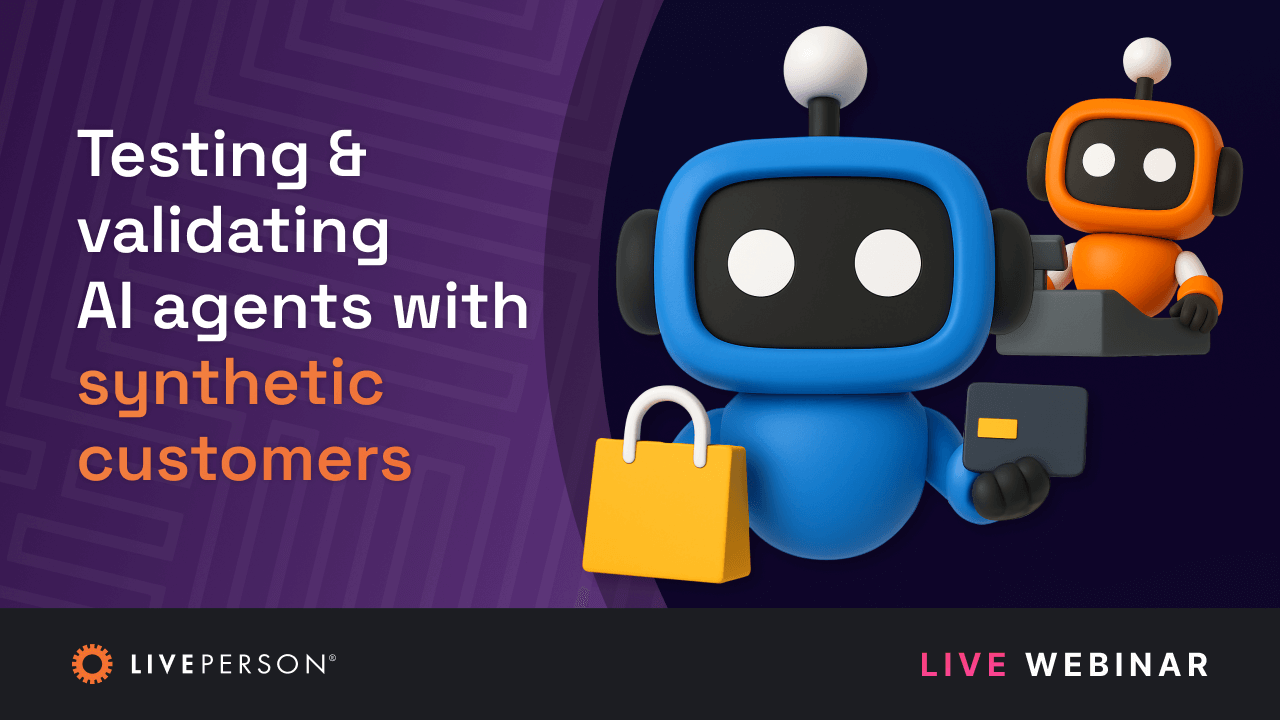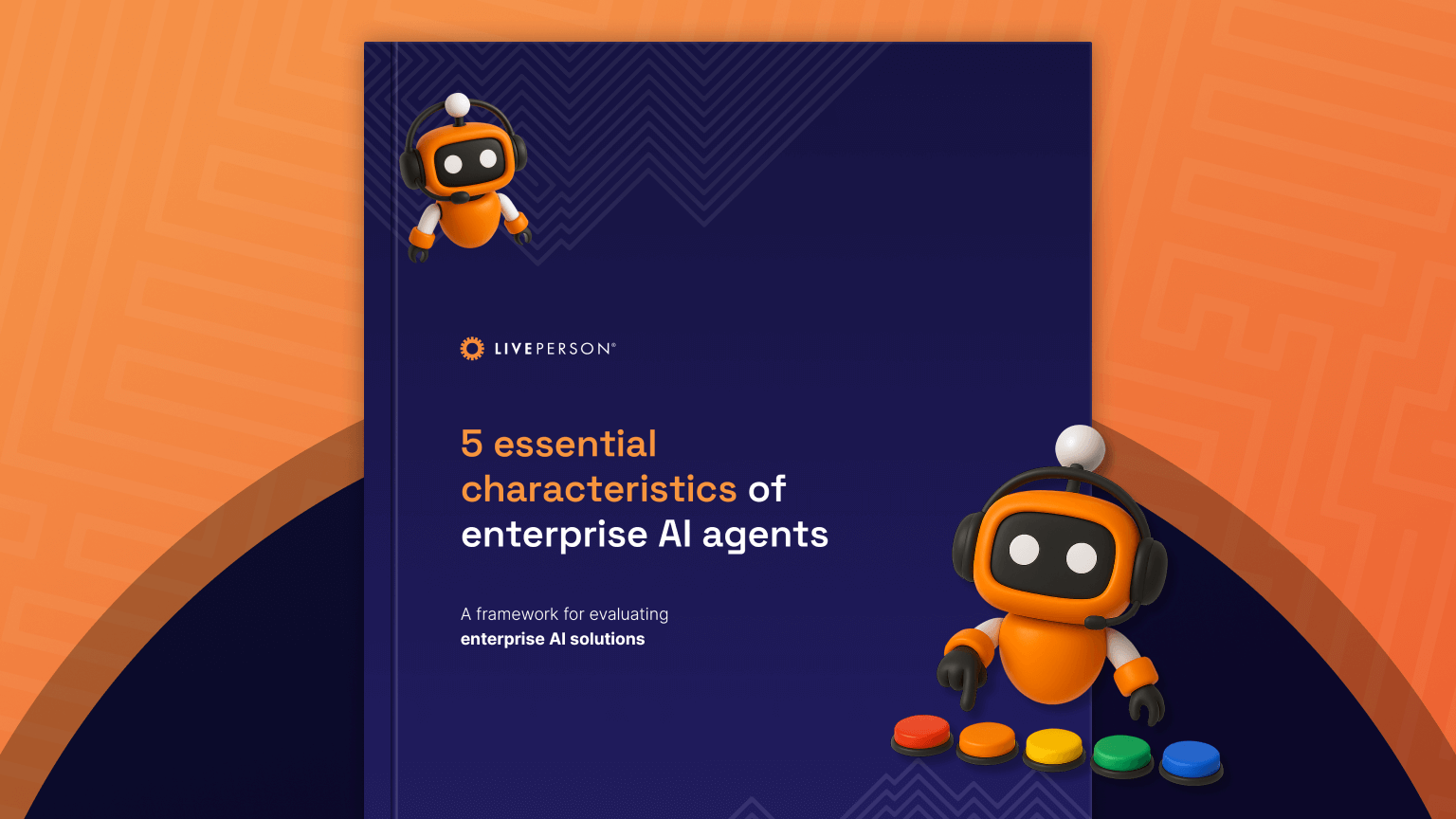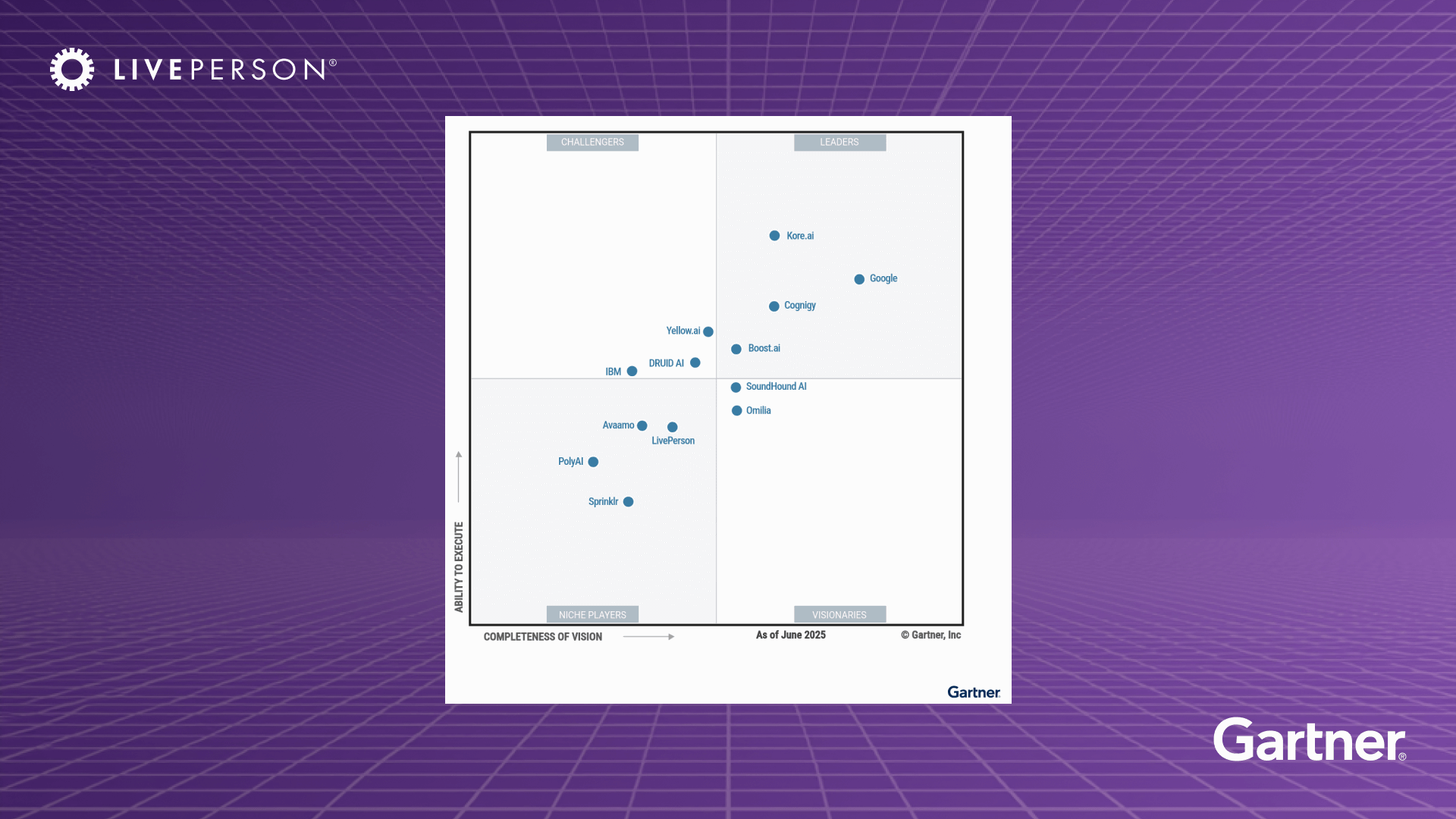article
Let’s get personal: Creating a more personalized customer experience with Conversational AI
Personalized customer experiences are made more powerful with Conversational AI
December 07, 2023 • 8 minutes
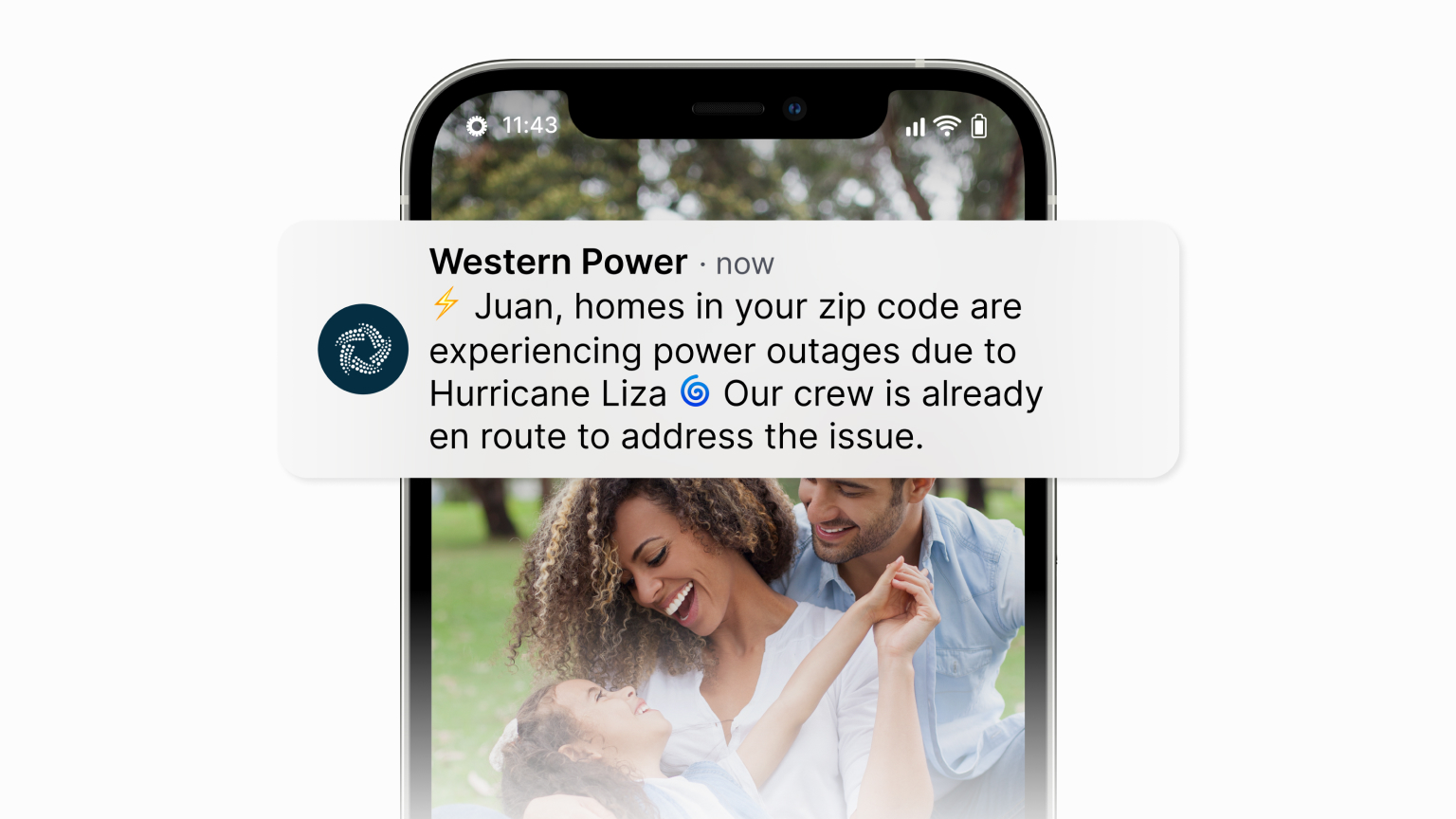
[Updated] Originally published December 7, 2022
Aside from expecting us to understand them, customers want us to know them. And to use that knowledge to provide highly personalized customer experiences. In multiple surveys, consumers want that personalized experience, and are more likely to make a purchase with brands that meet those wants:
- 67% of consumers say it’s important for brands to automatically adjust content based on their current context for a real-time personalized experience. (CMO.com)
- 91% of consumers say they are more likely to shop with brands that provide offers and recommendations that are relevant to them. (Accenture)
- 80% of consumers are more likely to make a purchase from a brand that provides personalized experiences. (Epsilon)
What is personalized customer experience?
Forrester defines personalization as “an experience that uses customer data and understanding to frame, guide, extend, and enhance interactions based on that person’s history, preferences, context, and intent.” Creating a personalized customer experience increases customer satisfaction, drives customer loyalty, and improves the customer journey.
Brands that implement personalization strategies can overcome surrounding and competing noise by connecting in ways that are relatable, appropriate, and beneficial to the consumer. In order to do this, brands should know their customers, and they can use that knowledge to build those personalized customer service experiences and predict the needs of their loyal customers. Using real-time customer data, they can deliver personalized offers, individualized messaging, personalized recommendations, and other customized experiences all aimed at driving customer loyalty.
What is an example of a personalized customer experience?
Microsoft personalized experiences for all users with its Xbox gaming platform. Microsoft knows when gamers log into the platform, what games they play, and how they play them. They leverage customer data like this and use AI to reinforce the desired outcome: delivering personalized customer experiences that led to a 40% increase in gamer engagement.
Whether it’s purchasing more, searching more, or taking advantage of various services a brand offers, this type of increased usage from personalization recommendations results in a valuable benefit to the customer and the business. Building a personalized customer experience that hit customer expectations across multiple channels is no longer a nice to have feature for customer experience leaders — it’s a must have.
How to provide personalized customer service via messaging
In the conversational messaging space, such as SMS messaging or in-app messaging, we have different information than we have in the web or content space. We can — and should — glean as much customer data from that first message as we can. This might include intent, product name, or historical contact information, which can be used to personalize the next response. Follow-up questions may be needed to collect additional information to provide that personalized customer experience. If we are communicating within an authenticated experience, such as an app that the consumer logs into, we have all kinds of information already collected about the consumer: purchase history, purchasing trends, historical conversations, and order status, among other information. All of it is valuable and can help us provide a great experience throughout the customer journey.
Existing customers should never have to tell us what we already know about them. Customers expect businesses to remember and use the relevant data they already provided to us. Repeatedly asking customers for information we already know diminishes confidence in the brand and implies that our systems do not talk to each other. We can avoid this by asking relevant questions for information and not repeating requests for information we already know. When we properly use the customer data we already know and combine it with insights that we learn from real-time responses, then we can create a personalized customer experience. Plus, we can talk to our customer base on their preferred channels as we would talk to someone in a one-on-one conversation.
That is the power of customer personalization: It takes us one step closer to providing messaging at scale.
Scaling your conversational personalization strategy
As messaging popularity rises, it becomes increasingly important to support conversations with automation to provide excellent service with the same number of resources. Since LivePerson launched messaging in 2017, and especially as consumers and contact centers struggled through the pandemic, we have seen explosive growth in messaging on our Conversational Cloud®. We also see that brands understand the importance of AI chatbot automation to support these personalized customer conversations.
In Q1 2022, 63% — over 60 million conversations — included some sort of automation, and 28% — over 25 million conversations — were fully automated with bot users. Automation is critical to scaling messaging, and can be applied in many ways to help brands meet their customer experience goals and successfully contain conversations within automation (meaning bots completing end-to-end tasks for consumers). Containment is reliant on providing personalized customer service, meaning a brand has to understand intent, customer preferences, and context to enhance the interaction.
At LivePerson, our innovation drives increased containment as we scale messaging, creating tools like MACS™, our Meaningful Automated Conversation Score™. MACS launched in November 2022 and is an innovative bot measurement that helps brands identify not only how their bots are performing, but also where they struggle. This helps overcome the challenges of traditional measurements like containment, CSAT, and NPS, which just don’t work well as chatbot metrics when trying to define bot success. MACS solves this by using machine learning to identify where and why the bot is failing (before you hear it through customer feedback), and then providing easy-to-access insights into those failures and the interactions that are performing worst. Then it applies a score to help you see how your bot is trending over thousands of conversations.
Our work in Conversational AI helps brands truly listen to consumers, then apply context, history, and knowledge to understand customer expectations, develop those incredibly valuable relationships, and deliver great customer satisfaction with better personalized experiences.
Valuing your customers: A personal use case
I would like to take you through a use case that might help reinforce the value of personalized customer service.
I have been with the same mobile telephone company for over 15 years — I know, I am not the norm! I’ve had countless customer interactions with them over the years to. My telephone company knows that I’ve added (and removed) new users to my plan as my children grew up. My telephone company knows what devices I like. They know that my partner and I rarely damage our phones. They even know that we always keep our devices through the full term of the contract, and beyond.
Yet, when I contact customer service reps with an issue or a question, it feels like it is the first time I have ever spoken to them. Why!?! I have invested a lot of money into my customer relationship with them, but I feel like they have invested nothing in their relationship with me.
Let’s look at how they could use personalization to make my customer journey with them better:
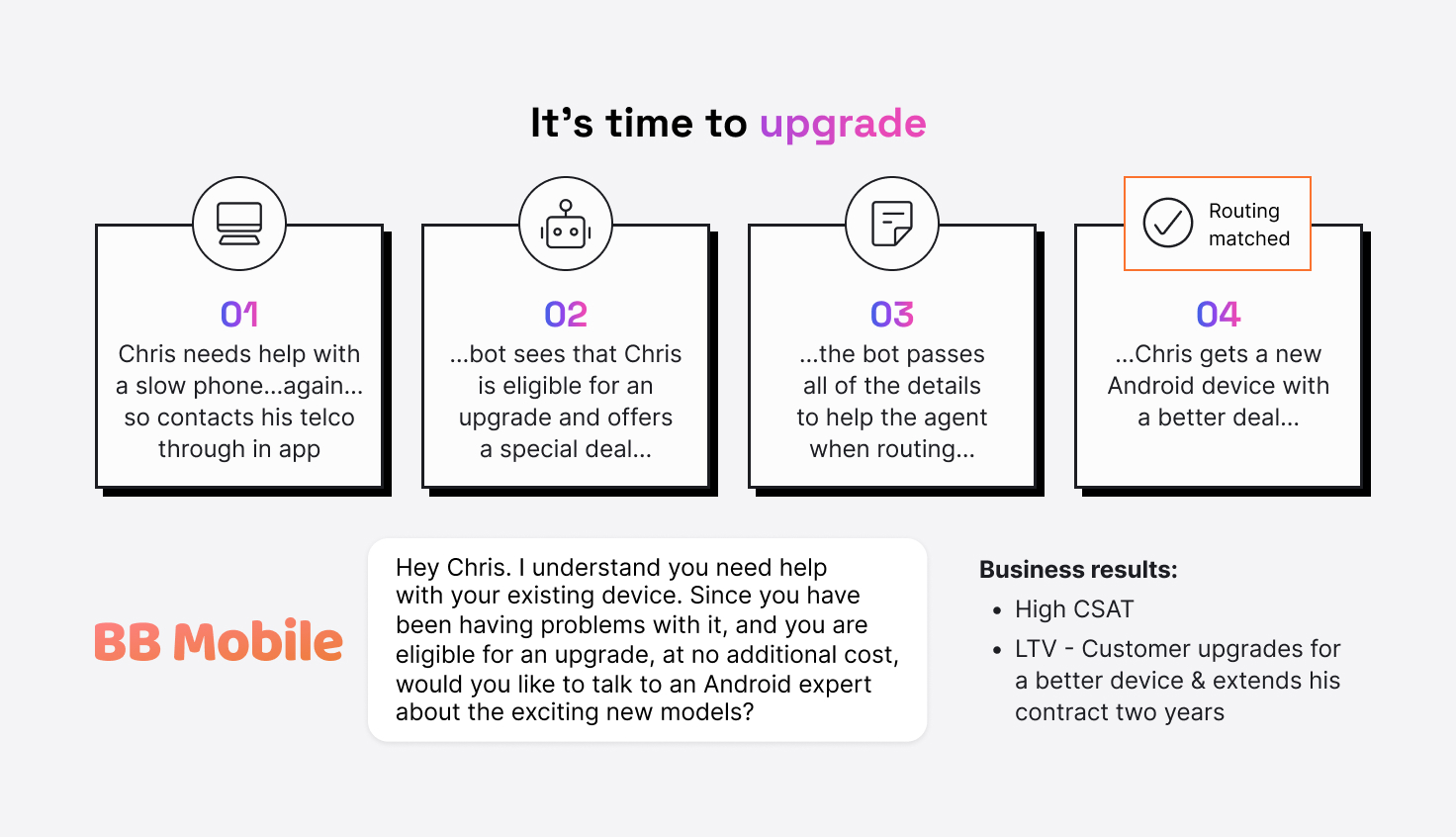
In this scenario, I have a problem with my phone. It is super slow when I browse the web and takes forever to watch my favorite YouTube puppy videos. I need help. That’s when I log into my telco brand’s app and start an in-app messaging conversation to access customer service. I type, “My device is really slow and I need help getting it fixed.”
The brand knows:
- My intent – troubleshoot my device
- My upgrade eligibility status – eligible for upgrade, per the CRM system
- Purchase history – I am an Android user, and have been for my entire relationship with the brand
Using this information, the brand can personalize the conversation. Instead of starting a troubleshooting flow or asking questions they already know the answer to, imagine that a bot lets me know it understands my intent, and uses the additional customer feedback I provide to create a personalized service and make me a special offer for a new Android at no additional cost.
As I think about this, and the fact that I still am paying device charges beyond my contract term, I’m interested in seeing what is out there. I let the bot know that, yes, I would like to discuss an upgrade. So the bot transfers me to an Android expert, and passes all my pertinent information to the human agent, who can pick up right where the bot left off. Enabling personalized customer service like this makes the experience of shopping online feel like experiences I’ve had at physical stores, without the hassle of leaving my home.
As a result, I get a new Android device, which allows me to watch my puppy videos and has several other cool capabilities that I didn’t even know I needed! And my telco has a highly satisfied customer, who has a new two-year contract and a higher lifetime value.
As I think about this, and the fact that I still am paying device charges beyond my contract term, I’m interested in seeing what is out there. I let the bot know that, yes, I would like to discuss an upgrade. So the bot transfers me to an Android expert, and passes all my pertinent information to the human agent, who can pick up right where the bot left off. Enabling personalized customer service like this makes the experience of shopping online feel like experiences I’ve had at physical stores, without the hassle of leaving my home.
As a result, I get a new Android device, which allows me to watch my puppy videos and has several other cool capabilities that I did not even know I needed! And my telco has a highly satisfied customer, who has a new two-year contract and a higher lifetime value.
This is a use case designed to get brands thinking about what a personalized customer service experience may look like. By using information that they know about my history with the brand, this telco was able to upgrade me and drive increased value from our relationship, through a positive, personalized customer experience.
Personalization in conversations across multiple customer service channels is not only possible, it is critical. Consumers expect it. Delivering personalized content and a customized experience to your customers doesn’t have to be a heavy lift. Working with Conversational AI software like LivePerson’s Conversational Cloud, you can deliver personalized service based on customers interests across multiple channels with ease.


